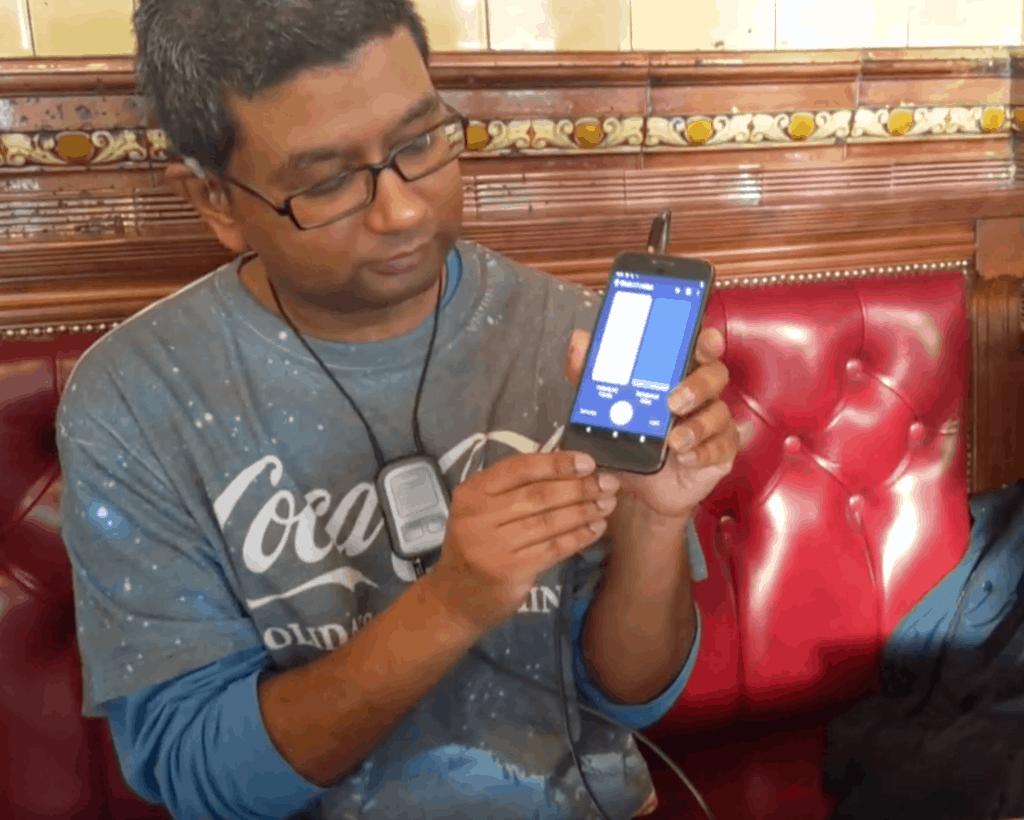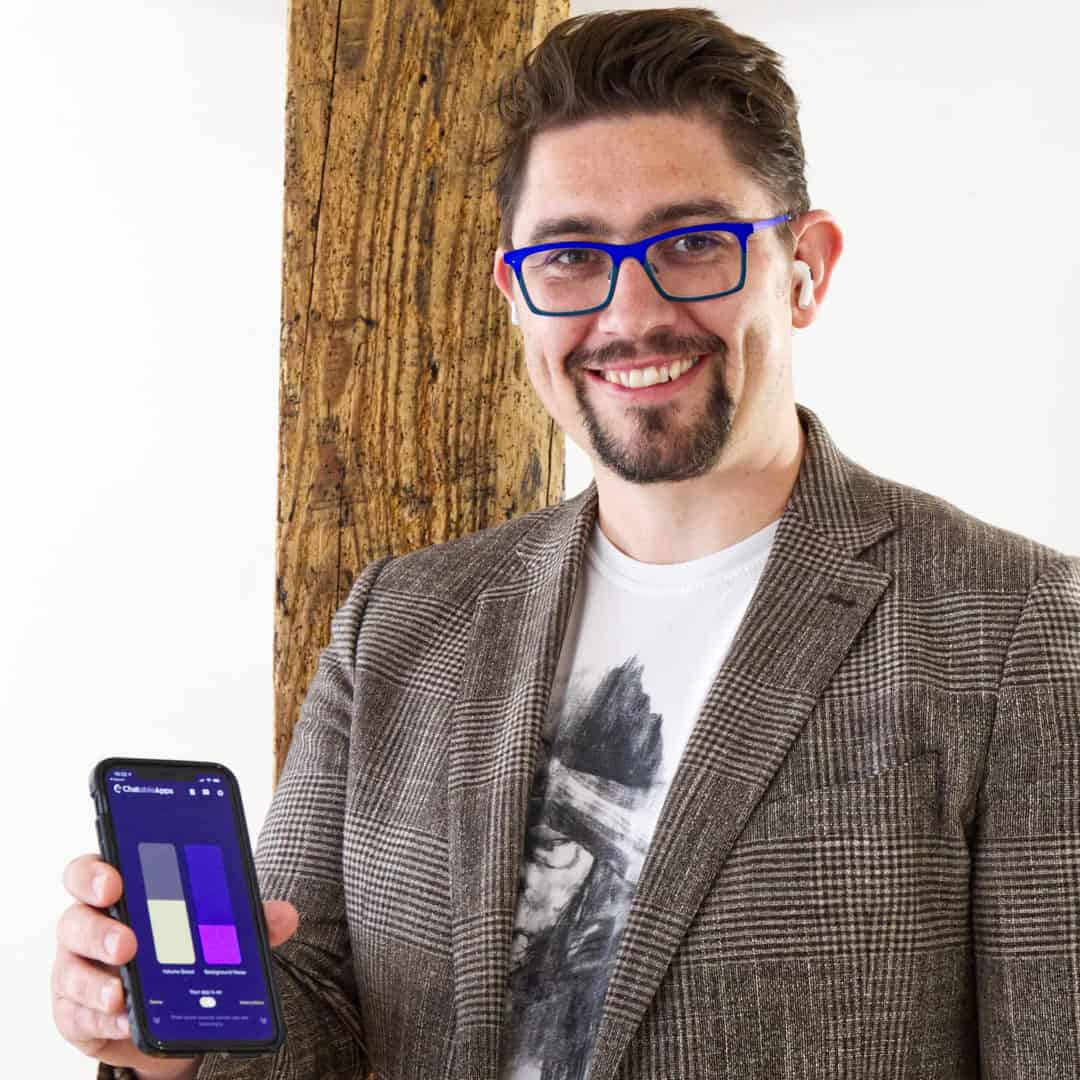If you suffer hearing loss, have trouble distinguishing words in a crowded room, or hearing the TV or following conversations through facemasks, Chatable and Giles have an accessible, affordable solution.
The UK-based app, Giles co-founded, uses a neuroscience-led AI approach to help people with hearing loss.
Giles Early Career
Giles studied Business and Technology at Sheffield Hallam University and later took a Post Grad diploma with the Chartered Institute of Marketing.
He gained marketing experience with companies in a wide variety of sectors. By 2011, he was Brand Manager for Toni and Guy and Unilver and from there moved to LIFX, both in the UK and San Francisco.
Giles then joined tech21 as their Head of Global Marketing, turning it into a world leader in Impact Protection for smartphones and tablets. It featured in Tech Track 100 (Sunday Times) UK fastest growing tech companies for three years.
In 2015, he became Director of New Business for Impact Tech Labs and built it from the ground up and ran the company’s day-to-day management. He pivoted this into NURVV, which offers runners’ wearable tech, where he was also Director of Business Operations. Again, Giles was responsible for taking the owners’ vision and turning it into a reality, and running the business on a day-to-day basis, building from proof of concept to fully functioning.
ChatableApps for Hearing Loss
How big a problem is hearing loss?
Chatable’s founders describe hearing loss as a global epidemic. One in six people is affected by some form of hearing loss in the UK. Australia and the US. In developing countries, that figure is much higher. In India, around 26% of the population suffer some form of hearing loss, and there is only one auditory clinic for every half a million people.
The World Health Organization says the global figure for disabling hearing loss is around 466 million people, yet the hearing aid manufacturing industry only sells around 15m hearing aids a year. Partly there is the cost factor. Private hearing aids in the US cost up to $10,000, and they only last between three and seven years.
Chatable’s beginnings
The pioneer behind Auditory Neuroscience is co-founder Dr. Andy Simpson. Andy had been working in academia in the fields of Auditory Neuroscience and artificial intelligence. Andy used funding from his family, to develop his AI solution.
Once he’d developed his AI, he realized it could be deployed in a smartphone app to provide easy help to those with hearing loss. He then went looking for the right partners to help him develop an app.
He found the perfect answer in co-founders are Aidan Sliney now Head of Product, and Brendan O’Driscoll, who is Chairman. Brendan and Aidan and George Boyle, the senior Android Engineer, had recently sold their successful Dublin start-up Soundwave, to Spotify. They also knew the perfect person to turn to for funding, having worked with him before.
They obtained seed funding from Mark Cuban of Shark Tank for both for the development of the app and initial salaries. Once the app was usable, Giles joined the founding team to take the vision forward.
The Development Stage


Giles has spent much of his time in coffee shops, meeting and talking to both audiologists and the people who suffer from hearing loss.
People with hearing loss don’t like going to noisy places as they struggle to distinguish a voice from all the other noise. Hearing aids don’t always help as they turn both voice and noise up.
Many rely on lip-reading. Jose, who Giles met, was typical. When they first chatted, Giles wondered if Jose even suffered any hearing loss problems. Only when by chance, Giles turned his head away, did he realize that Jose was lip-reading and couldn’t hear. Jose himself hadn’t realized that he was lip-reading.
Giles also spends much of his time talking to the users of the app. Andy’s original intention was to help people with hearing loss hear conversations more clearly in noisy places. However, they have now learned that the app can be used in many different ways, far beyond the original vision.
Many are putting it near the TV to distinguish the voices and, listening through headphones, can switch the volume down, which is ideal for neighbors or families sharing living space. Others are using it, in the same way, to listen to music. Students are asking if it will help them at university.
Airpods Pros provide extra benefit for those with milder hearing loss as they are also noise-canceling which helps remove the ambient noise and sound of their own voice. Initially, this can be odd for people watching tv, as they get the actors talking with no sound effects. The sliders mean you can add back in background noise and increase volume to what suits you.
When the app is used with headphones, the user has control of their environment. This has opened the possibility of a use way outside helping with hearing loss. It could be life-changing for people with autism, ADHD, hyperacusis, and similar conditions, enabling them to cut out all the noise that so distresses them but still tune into someone’s voice, far superior to a complete noise block. Chatable has yet to explore this fully.
What next for Chatable?

Just pre-COVID, Giles was fundraising in earnest, but it made sense to reprioritize given the global uncertainty. They had already raised £250k from UK audiologists, providing additional validation of their work and help to learn more about hearing loss and hearing aids.
The app launched in May on iOS and Android and is a simple solution but a game-changer for those with hearing loss. Support has come from Steve O’Hear at Tech Crunch and from the App Store Meet the Developer feature and App of the Day who have promoted them in 68 countries. It is offered on a subscription basis for £9.99 a month in the West, a very affordable figure compared to hearing aids. In India, they are offering it at just a dollar a month.
They are up and running with paying customers, but Giles feels more development work can improve the user experience. He says he knows if he is with someone in a crowded place, it will work fantastically. The challenge now is replicating that experience when we are not there, and the user is at home with no guidance, other than what’s in the app.
Many people with hearing loss are of a generation unused to apps, and some struggle at first on their own. Chatable now offers live chat, a free 30-minute helpline conversation, live chat in the app, and email support.
Giles says “We want to be able to help everyone use the app and learn what we need to do to improve it for the next person. For example, we had correspondence with a gentleman who has is deaf and with low vision, so at his request we immediately improved our VoiceOver capabilities for him and others who will benefit. The better we help people, the more usable the app is, the more we can understand and help people use Chatable the way they want to use it, the better for everyone”.
This increased communication also means they get to know more about their users, when they use the app, what for, and what they, Chatable, can do better. It helps them improve their marketing plans, learning where they will find the most users be it on Facebook or at the Rotary Clubs.
It is inspiring to hear Giles’s enthusiasm for the diversity of markets and people this app can help, both within and outside the hearing loss field. In the mid to long term, they want to use AI, not just for the app.
Which market will win out, it is too early to say. Giles tells me that people watch TV for an average of four hours a day, much longer than they have conversations, but on the other hand, the conversations they do have can have enormous significance.
Giles’ Advice to Others:
Just before we chatted, Giles had seen someone saying on LinkedIn that timing is the most important thing in business. He disagrees. Timing may be part of it, but without a good product, no amount of timing will help.
His advice is “to work on your focus and prioritization. In the early stages of a business, you are constantly assaulted by noise on all sides. There are those small things that make a lot of noise and the big strategic decisions that sit there quietly. It is very easy to overlook those big things. You answer the five emails that have just arrived or pick up the phone when it rings because it might be important. But if you do that, the big strategic things don’t get your attention.”
“Forming the right team behaviors is also critical”. Giles says that lies in ensuring communication works, that everyone has a common goal, inspiring people, and sharing the good and the bad.
Giles uses usertesting.com to record people using the app and then shares snippets with the team. If he finds users talking of the same problem, he can share a clip and say, “this is the fifth person who has talked about this, so it is definitely a problem. What can we do?” Then the team all jump in and brainstorm solutions.
“Team members need the same things you do to keep going.” Giles’s experience is that “you know when things are going wrong because suddenly, you hear a lot of silly suggestions. When things are going well, people work collectively and at speed. You should be able to let go and not micromanage.”
Finally, you need systems. Giles says he is not great on systems, and I told him about Dave Jenyns saying that few entrepreneurs are. “However, when you are developing a business, you are continually foraying off and looking outside the plan and challenging the original plan. You end up in a situation where you have told everyone what is going on, and then everything is in flux again.”
“In an ideal world, you put a system in place before you go off on something new. Then your head is free to think about that next thing and not worry whoever it was delegated to is away with the fairies.”
“Working on an early-stage business, you are working on the fly all the time. When you come across a new avenue, there is always the decision if you stick on the original plan and revisit this new avenue later or deviate off-plan. Systems have to fit each and every stage while leaving enough room to maneuver. “
“Systems should be gradually enabling you to work with a larger and longer horizon; what was planning for a week, becomes planning for a month, then six months as things become clear where you are going. The systems have to be flexible enough to cope with any change in course.”


